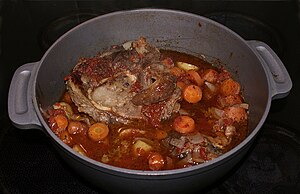Cookbook:Ossobuco Alla Milanese
| Ossobuco Alla Milanese | |
|---|---|
 | |
| Category | Veal recipes |
| Servings | 4 |
| Time | 2 hours, 45 minutes |
| Difficulty | |
Cookbook | Recipes | Ingredients | Equipment | Techniques | Cookbook Disambiguation Pages | Recipes | Cuisine of Italy | Meat
Ossobuco, when loosely translated from Italian, means hollowed bone; a reference to the large piece of marrow in the center of the veal shank bone.[1] It's a Milanese speciality of veal shanks cooked in meat broth and flavored with white wine.[2] Slowly braised, this relatively tough, yet flavorful cut of meat becomes meltingly tender, and the connective tissues and marrow dissolve into the sauce, making it rich and creamy.
The shank is a relatively cheap cut of veal which is readily available in most good supermarkets and butcher shops. Look for meaty hind-shanks cut from the top of the thigh [3] with a high proportion of meat to bone. Each piece should be about five inches across and one-inch to one-and-a-half inches thick.
This dish probably had its origins in a Milanese farmhouse during the late nineteenth century and most likely did not originally include tomatoes, a New World vegetable.[4] Ossobuco first became popular in the osterie of Milan, which were neighborhood restaurants of Italy's large cities.[4] These catered to the neighborhood's local residents but rarely if ever to tourists and foreigners.[4]
Traditional ossobuco was prepared with cinnamon, allspice, bay leaf and gremolata and today is called ossobuco in bianco (ossobuco in white sauce). The modern version has, by and large, replaced the older one. This new version includes tomatoes and mirepoix: carrot, celery and onion, flavored with herbs but no gremolata (although hybrid versions exist which include both tomato and gremolata). Risotto alla milanese is traditionally served with ossobuco, but goes well with polenta or mashed potatoes.[4]
Ingredients
[edit | edit source]- 4 slices veal hind shank, about 2.5–4 centimeters (1–1½ inches) thick
- 1 medium onion, chopped fine
- 3 ribs celery with leaves, chopped fine
- 1 medium carrot, chopped fine
- 2 cloves garlic, minced
- 3 tablespoons butter
- 4 tablespoons vegetable oil
- 240 ml (1 cup) dry white wine or white vermouth
- About 480 ml (2 cups) meat broth
- 3 tablespoons tomato paste
- 6 anchovy fillets, mashed
- ½ teaspoon dried thyme
- 2–3 bay leaves
- 2 strips lemon peel
- Salt
- Fresh ground pepper
- Flour
Procedure
[edit | edit source]- Preheat oven to 350°F.
- If the butcher has not done so, tie the shanks around the middle with kitchen twine; this will keep them from falling apart during cooking.
- Choose a heavy, covered roasting pan or Dutch oven which will just accommodate the veal shanks in one layer. Put the butter, two tablespoons of the oil, the onions, celery and carrots in the pan and sweat over medium heat until the vegetables have wilted—about 8 minutes. Add the garlic and lemon peel and sweat until they're fragrant, about 2 minutes more. Remove from the heat.
- Meanwhile, heat the remaining oil in a skillet until it is near the smoking point. Lightly flour the veal shanks and slip them into the oil. Richly brown the shanks on both of the cut sides, then place them in the roasting pan on top of the vegetables.
- Place the wine in the skillet and boil until reduced by one-half, deglazing the bottom of the pan. Pour this over the veal shanks.
- Heat the beef broth to a boil in the skillet, whisking in the tomato paste and anchovies. Add this to the veal shanks, along with the herbs, several grindings of pepper, and a large pinch of salt. The liquid should cover three quarters of the shanks. If not, add extra water.
- Bring the pot to a simmer, cover, and place in the oven. Cook for approximately 2 hours, turning and basting the shanks every half hour. If you notice that the cooking liquids have nearly evaporated, add hot water, about one half cup at a time. The veal is done when it is fork tender and falling from the bone.
- Transfer the shanks to a platter, remove the strings, and cover to keep warm. If the sauce seems watery, as is probable, place the pan on the stove top over high heat and reduce the cooking liquid until the sauce has a thick, creamy consistency. Pour the sauce over the shanks and serve.
Notes, tips, and variations
[edit | edit source]- There are variations to this dish that use other animal shanks, including turkey and venison shanks.
- The recipe calls for anchovies, which enrich the finished sauce without adding a fishy flavor. Don't omit them, even if you don't like anchovies.
- Traditionally, the cooking sauce is finished with a mixture of garlic, lemon zest and parsley called gremolata. It adds a burst of freshness to the finished dish. Gremolata consists of the grated zest of one lemon, one finely minced clove of garlic, and one tablespoon of finely chopped parsley. Add this mixture to the sauce at the end of the cooking, as it's being reduced.
- Ossobuco is almost always served with risotto. It's one of the few examples of Italian cooking where a starch is served with the main course. One may, for a change, substitute orzo or ancini de pepe cooked in meat broth and finished with butter and parmesan cheese.